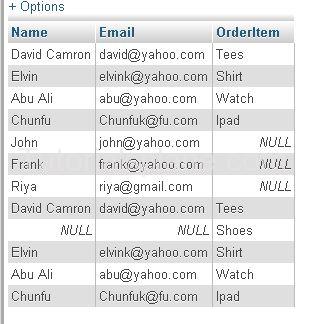Category Archives: Sql
SQL FOREIGN Key
SQL FOREIGN Key Constraint
A Foreign key is used to define the relation between two tables . A Foreign key points to the primary key in another table.
Suppose We Have The Following Tables :
Orders Table :

Note : “UserId” In “Orders” Table is the id of the users which is assigned to users in “Users” Table in “ID” column. The Values stored in “UserId” Column are referred from “Users” Table.
And
Users Table :
UserId In Orders table is the primary key in table Users ie . column ID(Primary Key).
Now to define this relation we have to make foreign key in Orders table.
There are Two Ways to Define Foreign Key :
1 . At the time of Creation of table :
Example
CREATE TABLE IF NOT EXISTS Orders (
OrderId int(11) NOT NULL,
UserId int(11) NOT NULL,
OrderItem varchar(100) NOT NULL,
Sysdate datetime NOT NULL,
CONSTRAINT usersID_FOREIGN_KEY FOREIGN KEY (UserId)
REFERENCES Users(ID);
) ;
2 . In Existing table :
Example
ALTER TABLE Orders ADD
CONSTRAINT usersID_FOREIGN_KEY FOREIGN KEY (UserId)
REFERENCES Users(ID);
Delete Foreign Key Constraint :
Example
ALTER TABLE Orders DROP
CONSTRAINT usersID_FOREIGN_KEY;
Note : In Mysql Following Query Works.
Example
ALTER TABLE Orders DROP
FOREIGN KEY usersID_FOREIGN_KEY;
SQL PRIMARY Key
SQL – PRIMARY Key Constraint :
1 . At The Time Of Table Creation :
SQL PRIMARY Key : PRIMARY Key Constraint is used to identify every record uniquely which can’t be null. There can be only one primary key in a table.
SQL – PRIMARY Key Constraint Syntax Example :
Example
ID int(11) NOT NULL,
Name varchar(110) NOT NULL,
Email varchar(100) NOT NULL,
CONSTRAINT USER_ID_PRIMARY_KEY PRIMARY KEY (ID)
) ;
Where USER_EMAIL is Constraint’s name you can choose constraint name as per you understanding.
2 .In Existing Table :
Example
ADD
CONSTRAINT USER_ID_PRIMARY_KEY PRIMARY KEY (ID);
Drop PRIMARY Key Constraint :
Example
DROP CONSTRAINT USER_ID_PRIMARY_KEY;
Note : In Mysql You have to Use Following Query to Drop the Constraint :
Example
DROP INDEX USER_ID_PRIMARY_KEY;
SQL – UNIQUE Key
SQL UNIQUE Key Constraint :
1 . At The Time Of Table Creation :
UNIQUE Key Constraint is used to identify every record uniquely. Multiple Unique Key can be in a sigle table.
SQL – UNIQUE Key Constraint Syntax Example :
Example
ID int(11) NOT NULL,
Name varchar(110) NOT NULL,
Email varchar(100) NOT NULL,
CONSTRAINT USER_EMAIL_UNIQUE_CONSTRAINT UNIQUE (Email)
) ;
Where USER_EMAIL is Constraint’s name you can choose constraint name as per you understanding.
2 .In Existing Table :
Example
ADD CONSTRAINT USER_EMAIL_UNIQUE_CONSTRAINT UNIQUE (Email);
Drop UNIQUE Key Constraint :
Example
DROP CONSTRAINT USER_EMAIL_UNIQUE_CONSTRAINT;
Note : In Mysql You have to Use Following Query to Drop the Constraint :
Example
DROP INDEX USER_EMAIL_UNIQUE_CONSTRAINT;
SQL – FULL JOIN
SQL -FULL JOIN
SQL – FUll JOIN `selects all rows from left table and the right table. It Returns both left & Right Join’s data together.
Syntax : SQL – FULL JOIN
SELECT LeftTable.ColumnName1,LeftTable.ColumnName2…RightTable.ColumnName1,RightTable.ColumnName2… FROM LeftTable FULL JOIN RightTable ON (LeftTable.ColumnName = RightTable.ColumnName);
We Have The Following Tables :
Orders Table :

Note : “UserId” In “Orders” Table is the id of the users which is assigned to users in “Users” Table in “ID” column. The Values stored in “UserId” Column are reffered from “Users” Table.
And
Users Table :
Left Join Example Can Be Explained Using The Above Two Tables :
Example
Or
Example
Note : Few Databases do not support FULL JOIN.
For Those databases which do not support full join you can use following method :
Example
UNION ALL
SELECT Users.Name,Users.Email,Orders.OrderItem FROM Users RIGHT JOIN Orders ON (Users.ID= Orders.UserId);
The Above Left Join Will Produce :
SQL – RIGHT JOIN
SQL – RIGHT JOIN
SQL – LEFT JOIN `selects all rows from right table and the matching rows from the left table.
SQL – RIGHT JOIN Syntax
:
SELECT LeftTable.ColumnName1,LeftTable.ColumnName2…RightTable.ColumnName1,RightTable.ColumnName2… FROM LeftTable RIGHT JOIN RightTable ON (LeftTable.ColumnName = RightTable.ColumnName);
We Have The Following Tables :
Orders Table :

Note : “UserId” In “Orders” Table is the id of the users which is assigned to users in “Users” Table in “ID” column. The Values stored in “UserId” Column are reffered from “Users” Table.
And
Users Table :
Left Join Example Can Be Explained Using The Above Two Tables :
Example
The Above Left Join Will Produce :
SQL – LEFT JOIN
SQL -LEFT JOIN
SQL – LEFT JOIN `selects all rows from left table and the matching rows from the right table.
Syntax : SQL – LEFT JOIN
SELECT LeftTable.ColumnName1,LeftTable.ColumnName2…RightTable.ColumnName1,RightTable.ColumnName2… FROM LeftTable LEFT JOIN RightTable ON (LeftTable.ColumnName = RightTable.ColumnName);
We Have The Following Tables :
Orders Table :

Note : “UserId” In “Orders” Table is the id of the users which is assigned to users in “Users” Table in “ID” column. The Values stored in “UserId” Column are reffered from “Users” Table.
And
Users Table :
Left Join Example Can Be Explained Using The Above Two Tables :
Example
The Above Left Join Will Produce :
SQL Joins – INNER JOIN
SQL JOINS
SQL – Joins are used to fetch data collectivly from two or more than two tables. It Selects column values from the two tables & results it as combined data.
SQL Joins (INNER JOIN)
Sql INNER JOIN Selects the data from Both the tables only the matching records from both table.
Create An Order Table Which We will Use for joins.
Order Table Used for JOINS
CREATE TABLE IF NOT EXISTS `Orders` (
`OrderId` int(11) NOT NULL,
`UserId` int(11) NOT NULL,
`OrderItem` varchar(100) NOT NULL,
`Sysdate` datetime NOT NULL
) ;
ALTER TABLE `orders`
ADD PRIMARY KEY (`OrderId`);
INSERT INTO `customersdb`.`orders` (`orderId`, `userId`, `orderItem`, `Sysdate`) VALUES (‘1’, ‘2’, ‘Tees’, ‘2015-03-19 00:00:00’);
INSERT INTO `customersdb`.`orders` (`orderId`, `userId`, `orderItem`, `Sysdate`) VALUES ( ‘2’,’3′, ‘Shoes’, ‘2015-03-20 00:00:00’);
INSERT INTO `customersdb`.`orders` (`orderId`, `userId`, `orderItem`, `Sysdate`) VALUES (‘3′,’5’, ‘Shirt’, ‘2015-03-21 00:00:00’);
INSERT INTO `customersdb`.`orders` (`orderId`, `userId`, `orderItem`, `Sysdate`) VALUES (‘4’, ‘6’, ‘Watch’, ‘2015-03-21 00:00:00’);
INSERT INTO `customersdb`.`orders` (`orderId`, `userId`, `orderItem`, `Sysdate`) VALUES (‘5′,’8’, ‘Ipad’, ‘2015-03-22 00:00:00’);
Now We Have The Following Tables :
Orders Table :

Note : “UserId” In “Orders” Table is the id of the users which is assigned to users in “Users” Table in “ID” column. The Values stored in “UserId” Column are reffered from “Users” Table.
And
Users Table :
Simple Join Example Can Be Explained Using The Above Two Tables :
Example
Note : Simple JOIN keyword also refers to the INNER JOIN.
ON – : Condition is key for the joining two tables which related the tables using common columns reffered from the tables..
After Running The Query the following Result will be produced :
SQL Between
SQL Between Clause
SQL – Between Clause is used to select the between the two specified range.
SQL Between Clause Syntax
SELECT ColumnName1,ColumnName2… FROM TableName WHERE columnName BETWEEN Range1 AND Range2 ;
Suppose We Have the following Table :
Example
Will Produce The Following Result :
SQL – NOT Between Clause Syntax-
NOT BETWEEN Clause selects only those records which does not come in the specified range.
SELECT ColumnName1,ColumnName2… FROM TableName WHERE columnName NOt BETWEEN Range1 AND Range2 ;
Example
Will Produce The Following Result :
SQL In Operator
SQL – In Clause :
SQL In Clause is used to pass multiple values in WHERE condtion .
SQL In CLause Syntax :
SQL NOT In CLause Syntax :
SQL NOT selectes the results excluding the spcified value .(values in NOT IN clause).
Example











